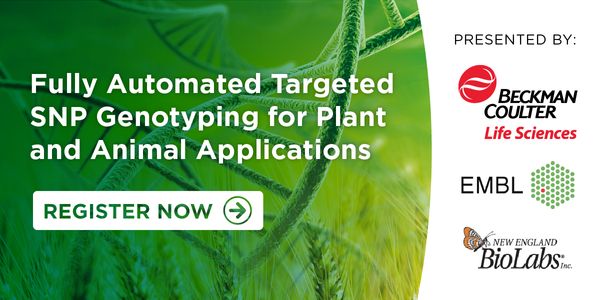Next-Generation Sequencing
Next-Generation Sequencing: A high-throughput method used to determine a portion of the nucleotide sequence of an individual's genome. This technique utilizes DNA sequencing technologies that are capable of processing multiple DNA sequences in parallel. Also called massively parallel sequencing and NGS.
-
SEP 10, 2020 | 11:00 AMLearning Objectives: 1. Understand the challenges of extracting DNA from human samples for microbiome analysis, and learn about the best technologies for accomplishing this 2. Learn about pr...Speaker: Dominic O'Neil, MS, MBASEP 10, 2020 | 12:00 AMFocusing on the urgent clinical problem of increasing carbapenem resistance in Enterobacteriaceae we have been evaluating detection methods in clinical microbiology and molecular transmissio...SEP 10, 2020 | 12:00 AMMicrobial biofilms form on all aquatic surfaces and can harbor pathogenic bacteria. In the aquaculture industry, Flavobacteria species can cause serious diseases and lead to high mortality....SEP 10, 2020 | 12:00 AMLessons around leveraging high-complexity next-generation sequencing tests for precision infectious disease discovery to guide patient treatment and improve health outcomes. Learning Objecti...SEP 09, 2020 | 7:30 AMHIV currently infects almost 40 million people worldwide. The virus is responsible for ~2 million new infections per year and ~1 million deaths. Like all retroviruses, HIV integrates a viral...Speaker: Dmitry Lyumkis, PhDSEP 08, 2020 | 11:00 PMMost currently used conventional influenza vaccines are based on 1940s technology. Advances in immunogen design and vaccine delivery emerging over the last decade open novel opportunities fo...SEP 08, 2020 | 9:00 AMAdvances in genomics and molecular biomarker testing have led to tremendous improvements, ushering in a new era of personalized medicine especially in the oncology practice. Many of these bi...JUL 22, 2020 | 10:00 AMDATE: July 23, 2020 TIME: 10:00 am PDT The SARS-CoV-2 pandemic has taken a toll on many sectors of the medical community. As the pandemic took a grip on the laboratory, the need for diagnost...JUL 02, 2020 | 1:30 PMGenetic diseases are known occur due to various types of mutations in the human genome. The molecular assays to diagnose these diseases have been developed based on the type of mutation comm...JUL 02, 2020 | 12:45 PMMolecular breeding can significantly reduce the cost and time required to deliver improved plant and animal species for agricultural use. Advancements in genomic technologies are acceleratin...JUL 02, 2020 | 12:15 PMThe study of human development and diseases relies on analysis of samples obtained and manipulated ex vivo. It is critical in such studies to know the provenance and confirm that the identit...JUL 01, 2020 | 2:00 PMLung cancer management has changed over the last few years with several actionable targets being recognised and mandated in the optimal management of these patients. The biomarker ordering p...JUL 01, 2020 | 1:30 PMGenetic carrier screening is a method to help couples discover whether they are at risk of passing on serious genetic disorders to their children. When carried out before conception or early...JUL 01, 2020 | 12:45 PMNGS is still perceived as a complex, hard to implement and validate method that requires highly experienced people. Outsourcing next-generation sequencing (NGS) testing could be an option to...JUL 01, 2020 | 12:15 PMLearn about how the new Ion Torrent Genexus System is addressing key challenges to next-generation sequencing (NGS) implementation, like hands-on time, time-to-result, user expertise, and af...JUL 01, 2020 | 12:15 PMHere I review the applications of Ion Torrent NGS technology in the field of microbiome research and some recent publications about it. With Ion Torrent 16S rRNA next generation sequencing,...JUN 25, 2020 | 7:00 AMDATE: June 25, 2020 TIME: 7:00am PT Genotyping assays are essential in a variety of plant and animal applications including Marker Assisted Selection (MAS) and Quantitative Trait Locus (QTL)...JUN 17, 2020 | 1:30 PMUnderstanding the complex interplay between a pathogen and the host response is important to developing effective vaccines and therapeutics. The nCounter® Analysis System and GeoMx®...Speaker: Joseph M. Beechem, PhD , Christopher E. Mason, PhD , Robert Schwartz, PhDJUN 17, 2020 | 6:00 AMNext-generation sequencing (NGS) is the primary technology used to identify genomic targets for vaccine development, detect emerging viral strains and monitor transmission patterns. Enhanced...JUN 03, 2020 | 12:00 AMNCI estimates that cancer will be the leading cause of death in 2030, worldwide. Checkpoint inhibitors and adoptive cell therapies (ACTs) cost up to ~$2 million/patient and have shown durabl...MAY 20, 2020 | 9:00 AMMany questions at the forefront of biology depend on the interactions of millions of single cells. My lab develops technologies for studying large numbers of single cells. In this talk, I wi...Speaker: Adam Abate, PhDMAY 20, 2020 | 7:30 AMPrecision medicine is the paradigm to develop treatments for patients based on molecular-targets that are effective in vivo when administered. In addition to identifying the molecular and ce...MAY 20, 2020 | 12:00 AMWe describe a mass spectrometry (MS) analytical platform resulting from the novel integration of acoustic droplet ejection (ADE) technology, an open-port interface (OPI), and electrospray io...Speaker: Luke Ghislain, PhDMAY 20, 2020 | 12:00 AMProteins are the functional blocks of any biological entity from 50 nm sized viruses to the 100 ft long mammals (blue whale). They perform intra cellular, tissue, organ, system, or organism...Speaker: Kursad Araz, PhD
SEP 10, 2020 | 11:00 AM
Learning Objectives: 1. Understand the challenges of extracting DNA from human samples for microbiome analysis, and learn about the best technologies for accomplishing this 2. Learn about pr...
Speaker:
Dominic O'Neil, MS, MBA
SEP 10, 2020 | 12:00 AM
Focusing on the urgent clinical problem of increasing carbapenem resistance in Enterobacteriaceae we have been evaluating detection methods in clinical microbiology and molecular transmissio...
SEP 10, 2020 | 12:00 AM
Microbial biofilms form on all aquatic surfaces and can harbor pathogenic bacteria. In the aquaculture industry, Flavobacteria species can cause serious diseases and lead to high mortality....
SEP 10, 2020 | 12:00 AM
Lessons around leveraging high-complexity next-generation sequencing tests for precision infectious disease discovery to guide patient treatment and improve health outcomes. Learning Objecti...
SEP 09, 2020 | 7:30 AM
HIV currently infects almost 40 million people worldwide. The virus is responsible for ~2 million new infections per year and ~1 million deaths. Like all retroviruses, HIV integrates a viral...
Speaker:
Dmitry Lyumkis, PhD
SEP 08, 2020 | 11:00 PM
Most currently used conventional influenza vaccines are based on 1940s technology. Advances in immunogen design and vaccine delivery emerging over the last decade open novel opportunities fo...
SEP 08, 2020 | 9:00 AM
Advances in genomics and molecular biomarker testing have led to tremendous improvements, ushering in a new era of personalized medicine especially in the oncology practice. Many of these bi...
JUL 22, 2020 | 10:00 AM
DATE: July 23, 2020 TIME: 10:00 am PDT The SARS-CoV-2 pandemic has taken a toll on many sectors of the medical community. As the pandemic took a grip on the laboratory, the need for diagnost...
JUL 02, 2020 | 1:30 PM
Genetic diseases are known occur due to various types of mutations in the human genome. The molecular assays to diagnose these diseases have been developed based on the type of mutation comm...
JUL 02, 2020 | 12:45 PM
Molecular breeding can significantly reduce the cost and time required to deliver improved plant and animal species for agricultural use. Advancements in genomic technologies are acceleratin...
JUL 02, 2020 | 12:15 PM
The study of human development and diseases relies on analysis of samples obtained and manipulated ex vivo. It is critical in such studies to know the provenance and confirm that the identit...
JUL 01, 2020 | 2:00 PM
Lung cancer management has changed over the last few years with several actionable targets being recognised and mandated in the optimal management of these patients. The biomarker ordering p...
JUL 01, 2020 | 1:30 PM
Genetic carrier screening is a method to help couples discover whether they are at risk of passing on serious genetic disorders to their children. When carried out before conception or early...
JUL 01, 2020 | 12:45 PM
NGS is still perceived as a complex, hard to implement and validate method that requires highly experienced people. Outsourcing next-generation sequencing (NGS) testing could be an option to...
JUL 01, 2020 | 12:15 PM
Learn about how the new Ion Torrent Genexus System is addressing key challenges to next-generation sequencing (NGS) implementation, like hands-on time, time-to-result, user expertise, and af...
JUL 01, 2020 | 12:15 PM
Here I review the applications of Ion Torrent NGS technology in the field of microbiome research and some recent publications about it. With Ion Torrent 16S rRNA next generation sequencing,...
JUN 25, 2020 | 7:00 AM
DATE: June 25, 2020 TIME: 7:00am PT Genotyping assays are essential in a variety of plant and animal applications including Marker Assisted Selection (MAS) and Quantitative Trait Locus (QTL)...
JUN 17, 2020 | 1:30 PM
Understanding the complex interplay between a pathogen and the host response is important to developing effective vaccines and therapeutics. The nCounter® Analysis System and GeoMx®...
Speaker:
Joseph M. Beechem, PhD
, Christopher E. Mason, PhD
, Robert Schwartz, PhD
JUN 17, 2020 | 6:00 AM
Next-generation sequencing (NGS) is the primary technology used to identify genomic targets for vaccine development, detect emerging viral strains and monitor transmission patterns. Enhanced...
JUN 03, 2020 | 12:00 AM
NCI estimates that cancer will be the leading cause of death in 2030, worldwide. Checkpoint inhibitors and adoptive cell therapies (ACTs) cost up to ~$2 million/patient and have shown durabl...
MAY 20, 2020 | 9:00 AM
Many questions at the forefront of biology depend on the interactions of millions of single cells. My lab develops technologies for studying large numbers of single cells. In this talk, I wi...
Speaker:
Adam Abate, PhD
MAY 20, 2020 | 7:30 AM
Precision medicine is the paradigm to develop treatments for patients based on molecular-targets that are effective in vivo when administered. In addition to identifying the molecular and ce...
MAY 20, 2020 | 12:00 AM
We describe a mass spectrometry (MS) analytical platform resulting from the novel integration of acoustic droplet ejection (ADE) technology, an open-port interface (OPI), and electrospray io...
Speaker:
Luke Ghislain, PhD
MAY 20, 2020 | 12:00 AM
Proteins are the functional blocks of any biological entity from 50 nm sized viruses to the 100 ft long mammals (blue whale). They perform intra cellular, tissue, organ, system, or organism...
Speaker:
Kursad Araz, PhD
























